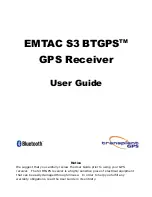
Teletrac, Inc. - Prism TM Information and Installation Guide
1622-0300 B1 3/18/04
43
But assuming we have precise clocks, how do we measure travel time? To explain it let's use a
goofy analogy:
Suppose there was a way to get both the satellite and the receiver to start playing "The Star-
Spangled Banner" at precisely 12 Noon. If sound could reach us from space (which, of course, is
ridiculous) then standing at the receiver we'd hear two versions of "The Star-Spangled Banner,"
one from our receiver and one from the satellite.
These two versions would be out of sync. The version coming from the satellite would be a little
delayed because it had to travel over 11,000 miles.
If we wanted to see just how delayed the satellite's version was, we could start delaying the
receiver's version until they fell into perfect sync.
The amount we have to shift back the receiver's version is equal to the travel time of the satellite's
version. So we just multiply that time times the speed of light and BINGO! we've got our distance
to the satellite.
That's basically how GPS works.
Only instead of "The Star-Spangled Banner" the satellites and receivers use something called a
"Pseudo Random Code." - which is probably easier to sing than "The Star-Spangled Banner."
A
R
ANDOM
C
ODE
?
The Pseudo Random Code (PRC) is a fundamental part of GPS. Physically it's just a very
complicated digital code, or in other words, a complicated sequence of "on" and "off" pulses as
shown here:
The signal is so complicated that it almost looks like random electrical noise. Hence the name
"Pseudo-Random."
There are several good reasons for that complexity: First, the complex pattern helps make sure
that the receiver doesn't accidentally sync up to some other signal. The patterns are so complex
that it's highly unlikely that a stray signal will have exactly the same shape.
Since each satellite has its own unique Pseudo-Random Code this complexity also guarantees
that the receiver won't accidentally pick up another satellite's signal. So all the satellites can use
the same frequency without jamming each other. And it makes it more difficult for a hostile force
to jam the system. In fact the Pseudo Random Code gives the DoD a way to control access to the
system.
But there's another reason for the complexity of the Pseudo Random Code, a reason that's
crucial to making GPS economical.
The codes make it possible to use "information theory" to "amplify" the GPS signal. And that's
why GPS receivers don't need big satellite dishes to receive the GPS signals.
We glossed over one point in our goofy Star-Spangled Banner analogy. It assumes that we can
guarantee that both the satellite and the receiver start generating their codes at exactly the same
time. But how do we make sure everybody is perfectly synced? Stay tuned and see.
Содержание Prism TM
Страница 2: ...Teletrac Inc Prism TM Information and Installation Guide 2 1622 0300 B1 3 18 04...
Страница 4: ...Teletrac Inc Prism TM Information and Installation Guide 4 1622 0300 B1 3 18 04...
Страница 6: ...Teletrac Inc Prism TM Information and Installation Guide 6 1622 0300 B1 3 18 04...
Страница 18: ...Teletrac Inc Prism TM Information and Installation Guide 18 1622 0300 B1 3 18 04...
Страница 20: ...Teletrac Inc Prism TM Information and Installation Guide 20 1622 0300 B1 3 18 04...
Страница 27: ...Teletrac Inc Prism TM Information and Installation Guide 1622 0300 B1 3 18 04 27...
Страница 35: ...Teletrac Inc Prism TM Information and Installation Guide 1622 0300 B1 3 18 04 35...
Страница 39: ...Teletrac Inc Prism TM Information and Installation Guide 1622 0300 B1 3 18 04 39...
Страница 49: ...Teletrac Inc Prism TM Information and Installation Guide 1622 0300 B1 3 18 04 49...
Страница 53: ...Teletrac Inc Prism TM Information and Installation Guide 1622 0300 B1 3 18 04 53...
Страница 59: ...Teletrac Inc Prism TM Information and Installation Guide 1622 0300 B1 3 18 04 59...
Страница 61: ...Teletrac Inc Prism TM Information and Installation Guide 1622 0300 B1 3 18 04 61...














































